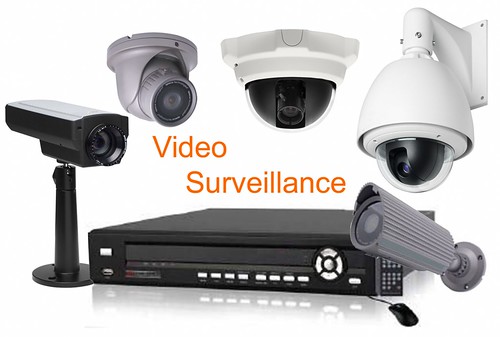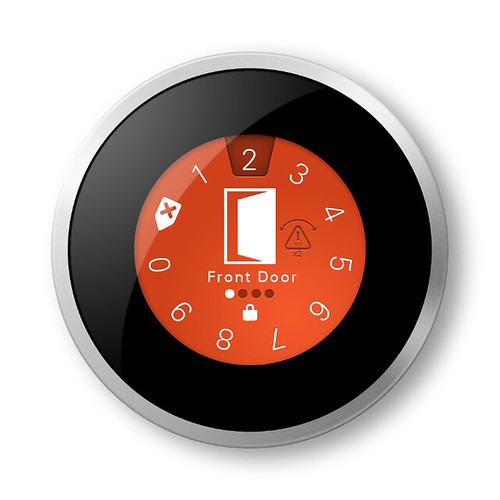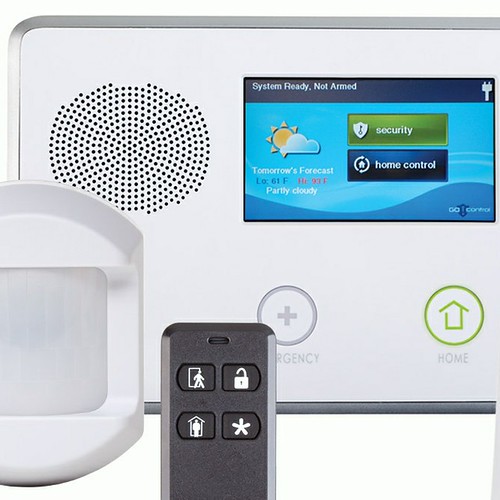As is always my goal, it's my hope that the process we're going to cover in researching, selecting, and installing a DIY Home Security System will be beneficial to readers of our blog. More than ever, I hope this particular series of posts ends up quite useful for future referencers of the topic, as good information on the Internets about this seem to be somewhat few and far between.
I'm also hopeful that readers that have some experience in either planning or installing their own system might be able to add some discussion to the mix.
When I began our search for a DIY Home Security System, I had no idea just how difficult it would be to find good information on this particular genre, or how sketchy the alarm industry seems to be. While I expected to just research, compare, purchase, and install, it didn't go the way I had planned. Everything I look into ends up feeling like it's misleading, a bait and switch of some sort, or even endless misdirection. It's no surprise you see so many people just hiring this job out or saying "just get a dog and a yard sign." In reality, shopping for and installing a home security system shouldn't be so difficult or uncertain.
Apparently, the home security system industry is SKETCHY. It's somewhat ironic given the particular purpose of a security system is to instill security (go figure), but if you've ever tried to research a system to install, you've likely noticed this same fact. I figure this blog topic alone should make the spammers crawl out of the woodwork in the comments, but more on this sketchiness in a minute.
In the last few decades a massive industry targeting the "do it yourselfer" has emerged, attempting to make everyone feel completely capable of doing anything from painting a room's walls to building an entire addition, almost entirely on their own. As you likely already know, this is an industry we're fully behind and one that has been greatly aided by the massive number of online resources and references that make this DIY life a more attainable possibility.
At the same time, advances in technology, from the massive public adoption of the Internet we've come to know and love, to the more recent prevalence of smartphones, tablets, and other IP enabled home devices (like those from Nest), has permitted a wide scale adoption of user friendly and functionally beautiful components that have begun permeating our everyday lives.
With all of these promotions of the ultra capable homeowner, and the penetration of "form marries function" devices which integrate into our homes, there is a shocking lack of options when it comes to the availability of a functional and beautiful DIY Home Security System that meets the typical DIYers primary criteria.
- It must work reliably.
- It must look good doing it.
- It must be affordable to install.
- It must be affordable to maintain.
Wendy and I have been looking for a new home security system that meets these criteria for a little while now. The system we already have in our home is the one that was there when we moved in. It does its job acceptably, and was a top-of-the-line system when it was installed, but it's missing many of the bells and whistles of modern systems, like Internet connectivity and alarm profiles. Add to it that some of the sensors have begun to go bad (which lead to one of the most nerve wracking nights of Wendy's life), making maintenance of the system cost prohibitive, from both a monetary and emotional standpoint.
In addition to our desire to upgrade to modern times, we want to add a few features to our system we don't currently have. Namely, video monitoring, alarm user profiles, and the possibility of future expansion into home automation integration. With the theft of our copper downspout over a year ago, the risk of "alley wanderers" next to our home, and even the occasional dog poop leaver, it would be nice to be able to keep an eye on the premises without the need to be standing at the window.

Photo Credit: Great Lakes Alarm
However, in the esoteric world of home security systems, one seems to deal more with the smarmy and skeevy than the upstanding and forthright. The high end systems you see in many television homes are not models you can just stroll into a store and purchase. Instead, you must know a guy who knows a guy who can come to your house and give you and estimate and then trust this unknown commodity to install and configure your system, all the while caring about your home as much as you do.
Call me a skeptic or just plain distrusting, but I simply don't like this approach. It leaves too much to chance, too many handshakes with accompanying head tilts and winks, and too often the feeling you just need to take a shower when you're done. There are a few other industries that fall into this sort of business category, such as sports memorabilia dealing, the always "going out of business" rug stores, and used care dealerships (sorry if you're in any of these lines of work, but you know what I'm talking about if you are).
I'm equally distrusting of the hard sell you encounter when going with the known commodities on the market. Few alarm installers/monitoring companies offer a clear and concise synopsis of costs associated with the purchase, install, and ongoing monitoring fees of their alarm, usually requiring "certified installers" to get the system into your home. Instead, most websites encourage you to enter your zip code, phone, and even address so one of their people can give you a "one on one consultation" (read: attempt to get you to shell over big bucks) to properly spec your home's system.
Besides the fact I'm interested in installing this new system myself, I want to shop around, I want to compare features, prices, capabilities, and I want to do it on my own time without having to schedule appointments. And more than anything, I'd rather not go through the experience while constantly talking to pushy people who are trying to sell me on their services of hardware.
Okay, I've done enough rambling about the difficulties, let's get down to brass tacks on the features I'm looking for.
Required Features
It almost goes without saying, but the system we're going to install must be a DIY system. This can be as simple or complex as necessary, but it has to be something that can be sold to an individual and installed by a non-certified installer.
The system must be a wireless system. There's no way I'm running wires to all of the windows, doors, motion detectors, etc. Wireless systems are the future of alarms. Whether we're talking about individual sensors sending RF, wifi, bluetooth, or any other types of communications to the base unit, wireless is the way to go.
Any system we install must have some level of Internet connectivity. Ideally, we'll be able to use our phone or a computer to arm/disarm the system, receive notifications when alarm events occur, check status, and even manage user accounts. Ideally, the Internet options may also allow integration with other systems for home automation, but this is more difficult since we've already established our home automation technologies.
The system's communications with the alarm company must be cellular capable and must not depend on an active landline or Internet connection. This eliminates the possibility that a phone line being cut
We must be able to use one of a variety of alarm monitoring companies. We're not interested in purchasing a system that is tied to a single alarm/monitoring company. When systems like this are installed you typically get a good intro rate, but before you know it the monthly cost begins to escalate and all of your savings are quickly wiped away. This single requirement does eliminate a good number of options, but just can't see buying and installing a system that has such an extreme limitation on vendors.
The system we end up going with will need some type of video monitoring, though it doesn't have to be a part of the security system itself. In other words, I can see getting a secondary component that does video monitoring that I can check in a secondary app/location. But like the previous requirement, the video storage can't be tied to a specific cloud storage provider with monthly costs. Additionally, the recorded video has to have the option of local or cloud based storage. I'd prefer video recording keep working even if the Internet goes down, and I'd rather not use constant bandwidth when recording. This eliminates things like DropCam from the running, which is too bad because I really like the new Pro version. Ideally, the video monitoring should also have the option for weatherproof cameras.
A nice to have for the system would be some level of home automation integration. We have Insteon throughout our house, but I'm relatively sure I can get some transition software or hardware if the system we choose uses UPB, Z-Wave, or another type of automation.
And finally, the system must be good looking. I know this may sound like a pure fluff aspect of the system, but the panels for the system will end up front and center in a few parts of our home. The last thing I want is some ugly looking keypads that look like they're straight out of the 1980s adorning our home's walls. I want the system to look sleek and slick in our 125 year old home. Is that asking too much? Maybe we could get Nest to come up with a security system offering?

Photo Credit: William Rihn and a Nest Security Concept we all wish existed.
Possibilities
My interest in a new alarm system was piqued when I started to see the various offerings from places like Xfinity, AT&T, and other companies offering bundled services. It sure made the users' lives look wonderful and easy, but the more I looked into the options the more I saw the drawbacks. Contract restrictions, restrictive technologies, and install limitations were just a few of the major issues I saw. So I started to look for systems that had similar functionality but didn't have the ties to individual vendors and service providers.
There seems to be about four real contenders when it comes to DIY systems to install that are not tied to specific monitoring companies/contracts. These systems are from Visonic, Elk, 2GIG, and GE Interlogix. These systems all meet the basic requirements that I've outlined above. I'll be looking into each in more detail in a future post, but that's at least a start.
As for video, I'm not entirely sure. I had hoped DropCam would have a better offering but they're focused on cloud only storage of video. Anyone have any good ideas on video monitoring and storage? I think the key here is wifi transmission of the images rather than hard wired, so that limits the playing field quite a bit.
So that's where we are now. I'm researching and learning a ton about the options that are out there. In the coming weeks I hope to determine a good solution and let you all know how we've made our determination. But as I mentioned, I'd love some input from people with experience in systems they really like. I haven't determined a budget at this point, but I'm thinking the $500-$1000 range is a good starting point. I know it may be more or less depending on what we're interested in adding to the system. We'd also like to get our monthly charges for monitoring down to about $20-$30 per month.
Thoughts? You know we'd love to hear them!

![]()
![]()